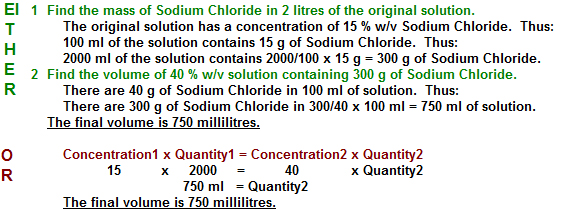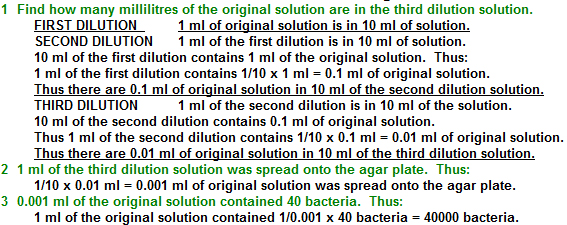For the next question, click on the Next Question button.
Question 1 of 6
- Find how many grams of solute are in 1 litre of the original solution.
400 ml of the original solution contains 1 g of solute. Thus:
1000 ml of the original solution contains 1000/400 x 1 g = 2.5 g of solute. - Find the volume of the final solution that will contain 2.5 g of solute.
The final solution will contain 1 g of solute in 900 ml of solution. thus:
The final solution will contain 2.5 g of solute in 2.5 / 1 x 900 ml = 2250 ml of solution. - Find the increase in volume of the solution.
Increase in Volume = Final Volume - Original Volume
Increase in Volume = 2250 - 1000 ml = 1250 ml - Since nothing else is added to the solution, the increase in volume must be due to the addition of water. Therefore, you need to add 1250 ml of water.
No, that is not the correct answer.
Have another go: just type in your new answer and press Return.
If you continue to have problems, click on the Answer button to see the answer.
For the next question, click on the Next Question button.
Question 2 of 6
| Menthol | 0.1 % | Hexachlorophene | 0.1 % |
| Glycerin | 10.0% | 70 % Ethanol, up to | 500ml |
- Find the mass of Menthol needed.
A concentration of 0.1 % w/v Menthol is needed in the final lotion.
100 ml of the lotion is to contain 0.1 g of Menthol. Thus:
250 ml of the lotion is to contain 250/100 x 0.1 g = 0.25 g of Menthol. - Find what volume of the 10 % solution contains 0.25 g of Menthol.
There are 10 g of Menthol in 100 ml of solution. Thus:You would need 2.5 ml (to 1 dec pl) of the 10 % Menthol solution.
There are 0.25 g of Menthol in 0.25/10 x 100 ml of solution.
There are 0.25 g of Menthol in 2.50 ml of solution.
No, that is not the correct answer.
Have another go: just type in your new answer and press Return.
If you continue to have problems, click on the Answer button to see the answer.
For the next question, click on the Next Question button.
Question 3 of 6
| Calamine | 125 g | Zinc Oxide | 125g | Strong Coal Tar Solution | 25g |
| Hydrous Wool Fat | 250 g | White Soft Paraffin | 475 g |
- Find the mass of the base (ie all components except Zinc Oxide) present.
Mass of base = 125 + 25 + 250 + 475 g = 875 g - Find the total mass of ointment that will be prepared.
The final ointment is to contain 20 % Zinc Oxide. The ointment will therefore
contain 80 % w/w base. You know that:
80 % of the ointment has a mass of 875 g. Thus:
100 % of the ointment has a mass of 100/80 x 875 g = 1093.75 g - Find the mass of Zinc Oxide in 1093.75 g of ointment.
Mass of Zinc Oxide = Total Mass - Mass of Base = 1093.75 - 875 g = 218.75 g - Find the mass of Zinc Oxide that must be added.
Mass to be added = Total Mass - Mass Already Present = 218.75 - 125 g = 93.75 g
93.75 g of Zinc Oxide needs to be added to the ointment.
No, that is not the correct answer.
Have another go: just type in your new answer and press Return.
If you continue to have problems, click on the Answer button to see the answer.
For the next question, click on the Next Question button.
Question 4 of 6
- Find the concentration of the solution required.
10000ml of the solution is to contain 1g of Histamine Phosphate. Thus:
100 ml of the solution is to contain 100/10000 x 1g = 0.01g of Histamine Phosphate.
The concentration required is 0.01g/100ml ie 0.01% w/v Histamine Phosphate. - Find the mass of Histamine Phosphate to be contained in 20 ml of the final solution.
100ml of the solution contains 0.01g of Histamine Phosphate. Thus:
20 ml of the solution contains 20/100 x 0.01g = 0.002g - Find the concentration of the source solution.
1ml of solution contains 0.35mg of Histamine Phosphate. Thus:
100 ml of solution contains 100/1 x 0.35mg = 35mg = 0.035g of Histamine Phosphate.
The concentration of the source solution is 0.035 % w/v. - Find the volume of the source solution containing 0.002 g of Histamine Phosphate.
There are 0.035g of Histamine Phosphate in 100ml of solution. Thus:
There are 0.002g of Histamine Phosphate in 0.002/0.035 x 100ml = 5.714ml = 5.71ml
No, that is not the correct answer.
Have another go: just type in your new answer and press Return.
If you continue to have problems, click on the Answer button to see the answer.
For the next question, click on the Next Question button.
Question 5 of 6
2 litres of 15 % w/v solution of Sodium Chloride is evaporated so that the final solution has a concentration of 40 % w/v. What is the volume in millilitres of the final solution?
Type in your answer and PRESS ENTER.

No, that is not the correct answer.
Have another go: just type in your new answer and press Return.
If you continue to have problems, click on the Answer button to see the answer.
Question 6 of 6

No, that is not the correct answer.
Have another go: just type in your new answer and press Return.
If you continue to have problems, click on the Answer button to see the answer.